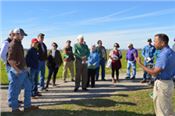|
30 Attend Master Farmer University

LSU AgCenter agronomist Syam Dodla discusses the effect of cover crops on crop yields
and water use at the Louisiana Master Farmer University program held at the Red River
Research Station in Bossier City.
Photo by Karol Osborne/LSU AgCenter
BOSSIER CITY, LA.
Agricultural producers from across the state earned Phase I and Phase II certification credit at a one-day Master Farmer University held Jan. 24 at the LSU AgCenter Red River Research Station.
“The Master Farmer University was put in place to offer both phases one and two at the same time to facilitate a more rapid process for our producers,” said Rogers Leonard, LSU AgCenter associate vice president. “We still offer Phase I at certain meetings, and Phase II during our field days throughout the year. But this university allows us to put those two phases together and expedite the training process.”
Ernest Girouard, AgCenter coordinator of the Louisiana Master Farmer Program, said one of the key advantages of this certification is producers are assumed to be in compliance with state soil and water regulations, and state and federal regulatory agencies understand that the producer is making every effort to comply with them.
Another benefit of the program is improvements made to land resources add value to a landowner’s property. Completing the resource management plan helps increase productivity and environmental sustainability over an extended period of time, Leonard said.
A total of 30 people participated in the university, with 12 producers receiving certification credit for phases one and two, AgCenter extension associate Allen Hogan said. Other participants took part to earn continuing education hours.
Master Farmers must complete an average of six hours of continuing education credits per year over five years and complete Phase III by having a viable resource management plan in place through the Natural Resources Conservation Service, Hogan said. Once confirmed, they can apply for recertification through the Louisiana Department of Agriculture and Forestry to be certified for five more years.
The Master Farmer program is growing because of increased environmental concerns by consumers, and those concerns are the same for producers, Girouard said.
“Farmers want to protect the environment because they live there; their children and family grow there. We have the same needs, the same requirements, and so the effort is unified,” he said.
“A clear demonstration of environmental compatibility, multiple conservation benefits and economic feasibility of farm conservation planning and implementation is the true impetus behind the program,” said Michael Schooler, Louisiana Department of Agriculture and Forestry environmental specialist.
To be certified as a Master Farmer, participants must complete all three phases of the program. To date 239 producers have become fully certified and about 3,300 are seeking certification, Girouard said.
Phase one classroom training included presentations covering a broad range of topics including conservation planning process and its implementation, sewer system requirements, pesticide issue updates, nonpoint-source pollution, watershed management and scenic rivers, agricultural prescribed burn education and certification, and state environmental updates, said James Hendrix, AgCenter area agent and event organizer.
During Phase II of the training, AgCenter experts led participants through four field tours that focused on water quality and cover crops. Phase III is primarily overseen by NRCS.
Louisiana Cooperative Extension Service agents and specialists help facilitate the interaction, but Phase III is based on a resource conservation plan approved by NRCS and then submitted to the LDAF, Leonard said.
“We’re fortunate to have a team of experts who are knowledgeable on two fronts,” said Tensas Parish farmer Brooks Blanche. “They understand environmental stewardship and practical implementation practices, and they have a real working knowledge of what is going to increase profitability of the farm.”
Blanche said this is his first Louisiana Master Farmer meeting, and he is looking forward to having a resource management plan in place to learn what resources are available.
“The resource management plan is important because it gives us and the landowners an opportunity to look at their entire operation, not just the concern or issue that they often come to us with, and gives us an opportunity to point out other ways that we can help them,” NRCS conservation agronomist Chris Coreil said.
The resource management plan “is not cut in stone” but is a living document that allows producers to extend conservation efforts, or modify those efforts, in order to comply with the contract and not lose financial benefits, Girouard said.
“I want to use the program do some land forming, put in some drop pipes and get a general idea of what the whole farm needs in order to start making progress for the conservation programs,” said Tensas Parish producer Lavance Herring.
NRCS offers both technical and financial assistance to producers. “The technical assistance comes in the planning phase, and it’s free; there is no cost there at all. The financial assistance comes in when trying to help them afford some of the conservation measures that we are recommending and they are choosing,” Coreil said.
“What we’re trying to do is point out that most of the conservation measures that they implement to protect water quality, quantity, wildlife habitat and soil quality also make them more profitable. They are interconnected,” he added.
The Louisiana Master Farmer program is conducted through a partnership with the AgCenter, USDA, NRCS, LDAF, the Louisiana Farm Bureau Federation and the Louisiana Cattlemen’s Association. ∆
|
|